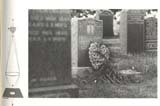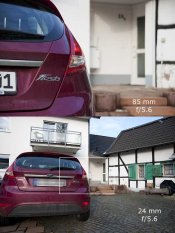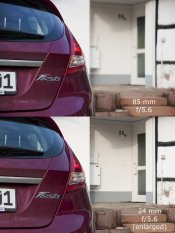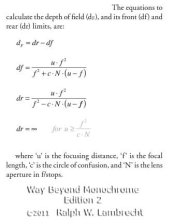Diapositivo
Subscriber
In reading the interesting comments to the tests carried on by the site theonlinephotographer, quoted by Lee, I ended on Wikipedia, normally not the best place where to look for reliable information admittedly, and I found this at the voice "Depth of field"
A subject distance is decreased, the subject magnification increases, and eventually becomes large in comparison with the hyperfocal magnification. Thus the effect of focal length is greatest near the hyperfocal distance, and decreases as subject distance is decreased. However, the near/far perspective will differ for different focal lengths, so the difference in DOF may not be readily apparent.
[formulas here, that don't cut-and-paste well]
so that for a given magnification, DOF is essentially independent of focal length. Stated otherwise, for the same subject magnification and the same f-number, all focal lengths for a given image format give approximately the same DOF. This statement is true only when the subject distance is small in comparison with the hyperfocal distance, however.
This somehow justifies the images published by Ralph with the apparent inconsistency of the principle in the macro world. The "advantage" of the higher DoF would exist only from somewhere near the hyperfocal distance on.
In the macro field, lenses work at distances that are much below the hyperfocal distance and, in that working range, the DoF advantage of shorter focal lengths disappears.
Hence the success of 100mm macro for field work, and let's say the fact that the 4:3 camera are not considered more suitable for macro work than the 135 cameras. If the DoF advantage of shorter focal lengths had applied to all focusing distances, 4:3 users would have enjoyed a "free meal"* so to speak, and the other formats would be at strong disadvantage, and macro photography would be a selling point for 4:3 material.
Fabrizio
* That's because the small decay of resolution due to a smaller sensor is probably much less important, in macrophotography, than an increased DoF which is the constant worry and trouble of macro phogographers.
A subject distance is decreased, the subject magnification increases, and eventually becomes large in comparison with the hyperfocal magnification. Thus the effect of focal length is greatest near the hyperfocal distance, and decreases as subject distance is decreased. However, the near/far perspective will differ for different focal lengths, so the difference in DOF may not be readily apparent.
[formulas here, that don't cut-and-paste well]
so that for a given magnification, DOF is essentially independent of focal length. Stated otherwise, for the same subject magnification and the same f-number, all focal lengths for a given image format give approximately the same DOF. This statement is true only when the subject distance is small in comparison with the hyperfocal distance, however.
This somehow justifies the images published by Ralph with the apparent inconsistency of the principle in the macro world. The "advantage" of the higher DoF would exist only from somewhere near the hyperfocal distance on.
In the macro field, lenses work at distances that are much below the hyperfocal distance and, in that working range, the DoF advantage of shorter focal lengths disappears.
Hence the success of 100mm macro for field work, and let's say the fact that the 4:3 camera are not considered more suitable for macro work than the 135 cameras. If the DoF advantage of shorter focal lengths had applied to all focusing distances, 4:3 users would have enjoyed a "free meal"* so to speak, and the other formats would be at strong disadvantage, and macro photography would be a selling point for 4:3 material.
Fabrizio
* That's because the small decay of resolution due to a smaller sensor is probably much less important, in macrophotography, than an increased DoF which is the constant worry and trouble of macro phogographers.

























